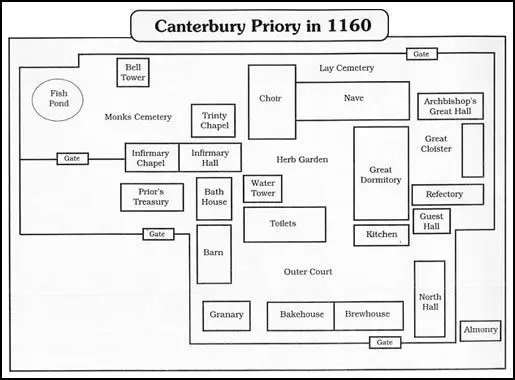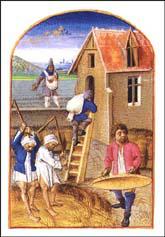Norman Monasteries
Most of the Normans who arrived with William the Conqueror in 1066 were devout Christians. Norman landowners in England gave a considerable amount of money for the building of churches and monasteries.
The Clare family were great supporters of the Church. In about 1135, Richard of Clare, provided the land and the money for the building of a priory in Tonbridge. After 1140 the Priory of St Mary Magdalene supplied the priests for the villages controlled by the Clare family.
One of the first monasteries built by the Normans was Canterbury Priory. With the support of Lanfranc, Archbishop of Canterbury, it soon became one of the most important monasteries in England. Lanfranc left instructions that all future Archbishops of Canterbury should be elected by the monks of Canterbury Priory.
The monks of Canterbury Priory were followers of St. Benedict, who had established several monasteries in Italy in the 6th century. St. Benedict insisted that his monks obeyed certain rules. One rule was that they had to pray eight times a day. Another rule was that they should work with their hands. The monks were encouraged to work in the fields, as well as doing their own cooking, washing and cleaning.
Benedictine monks were instructed to eat two simple meals a day and were not allowed to eat expensive food such as meat. The monks were also told that they should not spend their time talking to each other. A prosperous monk would be expected to donate all his personal wealth to the monastery. While in the monastery a Benedictine monk had to wear a habit made of dark, coarse, hard-wearing material.

When rich Normans died they often left some of their money and land to monasteries. People were especially generous to Canterbury Priory. By 1200 Canterbury Priory had been given land in Kent, Essex, Surrey, Suffolk, Norfolk, Devon, Oxfordshire and Ireland.
Land owned by Canterbury Priory was a source of great wealth. Twice a year, at Easter and Michaelmas, a monk would travel to the villages owned by Canterbury Priory to collect the rents from their tenants. By the end of the 13th century Canterbury Priory was making a net profit of over £2,000 a year from the land that it owned.
Another source of income was the collection of religious relics associated with Thomas Becket. People suffering from diseases and illnesses believed they would be cured if they touched these holy relics. In gratitude, the pilgrims donated money to the priory. In some years it was not unusual for the monastery to receive over a £1,000 from grateful pilgrims.
Despite these revenues, the priory was deeply in debt. In 1285 the priory owed £4,924.18s. 4d. Although the monks had taken a vow of poverty, it became obvious that they were spending much of their large income on themselves. Even with an income of £3,000 a year the monks thought it necessary to borrow money to help pay for their expensive lifestyle.
The monks spent a vast amount of money on food. One visitor was surprised when he discovered that the monks enjoyed sixteen-course meals, including the serving of meat, a food that St. Benedict had forbidden them to eat. The monks were especially fond of fish. The priory accounts show that in some years the monks spent nearly £250 a year on fish. Wine from France was another luxury item that the monks enjoyed.
The monks employed a large number of servants to look after them. By the end of the 13th century, the accounts reveal that there were more servants in Canterbury Priory than monks. The monks employed people to buy and cook their food, wait on them during dinner, tend their gardens, look after their animals, wash their clothes, and to clean and repair the monastery. The monks also paid actors and musicians to entertain them.
Benedictine monks took a vow to help the poor. The priory appointed an almoner who was in charge of organising their charity work. He had his own building outside the gates of the priory. However, only about £20 a year was given to the almoner for this work. This was less than what the monks were spending on clothes every year.
A study of the priory accounts reveal that between 1284 and 1373, less than one per cent of the almoner's income was given to the poor who sought help from the priory. The rest of the almoner's money was spent on maintaining the household and in gifts to the monks in the priory, who claimed that they were so poor they needed financial help.

Primary Sources
(1) William of Malmesbury, Deeds of the Kings of England (c. 1140)
To be a member of the Cistercian order... is now believed to be the surest way to heaven... Certainly many of their regulations seem severe... they wear nothing made with furs or linen... They have two tunics with hoods, but no additional garments... they do not take more than one meal a day, except on Sunday. They never leave the cloister but for the purpose of labour, nor do they ever speak, either there or elsewhere, save only to the abbot or prior... While they look after the stranger and the sick, they inflict intolerable tortures on their own bodies, for the health of their souls.
(2) Walter Map, Courtiers' Trifles (c. 1215)
The Cistercians came to England... They obtain land from a rich man... by much pretending of innocence and... putting in God at every other word. The wood is cut down and levelled into a plain... bushes give place to barley, willows to wheat... in order to give them full time for these operations, their prayers have to be somewhat shortened... The Cistercians do not eat meat... Yet they keep pigs to the number of many thousands, and sell the bacon - though perhaps not quite all of it. The heads, legs, and feet they neither give away, throw away, nor sell. What becomes of them God knows.
(3) Statement issued by a group of Cistercians in 1152.
We reject... fur garments, the linen and the mattresses on the beds, and also the variety of dishes at meals... we will live by our own labour... and condemn the use of tithes... We will not live in cities, towns or villages, but in places far from the haunts of men.
